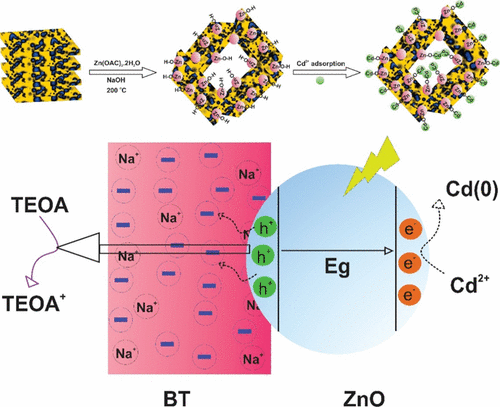Our official English website, www.x-mol.net, welcomes your
feedback! (Note: you will need to create a separate account there.)
Photoreduction and Removal of Cadmium Ions over Bentonite Clay-Supported Zinc Oxide Microcubes in an Aqueous Solution.
ACS Omega ( IF 3.7 ) Pub Date : 2020-05-28 , DOI: 10.1021/acsomega.0c01219 Hossein Salmanvandi 1 , Parizad Rezaei 1 , Yousef Tamsilian 2
ACS Omega ( IF 3.7 ) Pub Date : 2020-05-28 , DOI: 10.1021/acsomega.0c01219 Hossein Salmanvandi 1 , Parizad Rezaei 1 , Yousef Tamsilian 2
Affiliation

|
Cadmium ion is toxic to organisms and shows persistence because of its nondegradability. Photoreduction of the cadmium ion (Cd(II)) was studied using a bentonite-supported Zn oxide (ZnO/BT) photocatalyst in an aqueous medium under ultraviolet light. The prepared ZnO/BT photocatalyst was characterized by diffuse reflectance spectroscopy, field-emission scanning electron microscopy, Fourier transform infrared spectroscopy, X-ray diffraction, photoluminescence spectroscopy, transmission electron microscopy, energy-dispersive spectroscopy, and Brunauer–Emmett–Teller/Barrett–Joyner–Halenda analysis. The effects of main parameters including pH, contact time, initial concentration of cadmium(II) ion, light intensity, temperature, and the photocatalyst dosage were investigated for obtaining appreciate reduction/removal efficiency. The maximum reduction/removal efficiency of 74.8% was obtained at optimized values which were found to be at pH 5, 6 h contact time, 6 ppm Cd(II) ion, 200 W UV light, 45 °C temperature, and 4 g/L of ZnO/BT. Reduction/removal of Cd(II) was significantly affected by light intensity so that the increment in UV intensity from 0 to 200 increased the reduction/removal efficiency from 61.2 to 76.8%. This study reports an inexpensive and environmentally friendly photocatalyst for Cd2+ reduction in real samples and prospective photoelectric materials.
中文翻译:

在水溶液中膨润土粘土负载的氧化锌微立方体上光还原和去除镉离子。
镉离子对生物有毒,并且由于其不可降解性而表现出持久性。使用膨润土负载的氧化锌(ZnO / BT)光催化剂在水性介质中于紫外光下研究了镉离子(Cd(II))的光还原。制备的ZnO / BT光催化剂的特征在于漫反射光谱,场发射扫描电子显微镜,傅立叶变换红外光谱,X射线衍射,光致发光光谱,透射电子显微镜,能量色散光谱以及Brunauer-Emmett-Teller / Barrett –Joyner–Halenda分析。研究了pH,接触时间,镉(II)离子初始浓度,光强度,温度和光催化剂用量等主要参数的影响,以期获得降低/去除效果。在pH值为5,接触时间为6 h,Cd(II)离子浓度为6 ppm,200 W紫外线,45°C温度和4 g / g的最佳值下,最大还原/去除效率为74.8%。 L的ZnO / BT。Cd(II)的减少/去除受到光强度的显着影响,因此UV强度从0到200的增加使减少/去除效率从61.2增至76.8%。这项研究报告了一种廉价且环保的镉光催化剂实际样品和预期的光电材料减少2+。
更新日期:2020-05-28
中文翻译:

在水溶液中膨润土粘土负载的氧化锌微立方体上光还原和去除镉离子。
镉离子对生物有毒,并且由于其不可降解性而表现出持久性。使用膨润土负载的氧化锌(ZnO / BT)光催化剂在水性介质中于紫外光下研究了镉离子(Cd(II))的光还原。制备的ZnO / BT光催化剂的特征在于漫反射光谱,场发射扫描电子显微镜,傅立叶变换红外光谱,X射线衍射,光致发光光谱,透射电子显微镜,能量色散光谱以及Brunauer-Emmett-Teller / Barrett –Joyner–Halenda分析。研究了pH,接触时间,镉(II)离子初始浓度,光强度,温度和光催化剂用量等主要参数的影响,以期获得降低/去除效果。在pH值为5,接触时间为6 h,Cd(II)离子浓度为6 ppm,200 W紫外线,45°C温度和4 g / g的最佳值下,最大还原/去除效率为74.8%。 L的ZnO / BT。Cd(II)的减少/去除受到光强度的显着影响,因此UV强度从0到200的增加使减少/去除效率从61.2增至76.8%。这项研究报告了一种廉价且环保的镉光催化剂实际样品和预期的光电材料减少2+。
















































 京公网安备 11010802027423号
京公网安备 11010802027423号